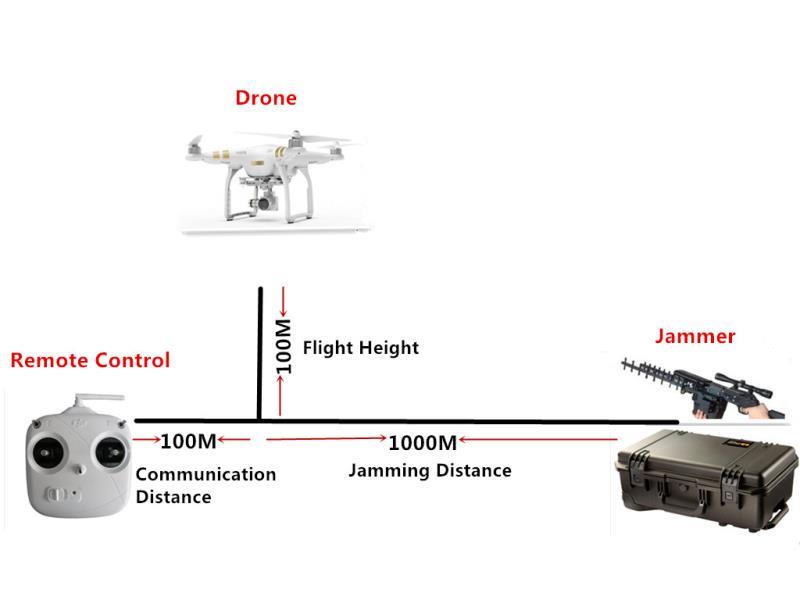The handheld drone jammer gun is a high-power, rifle-style device that blocks control and GPS signals on most commercial drones. Covering multiple frequency bands, it offers long-range, targeted interference with a simple power-on and trigger pull—keeping your airspace secure.



FAQS
1. Will anti-drone guns interfere with other electronic devices?
No, they won’t. The electromagnetic signals emitted by the drone jammer operate strictly within the frequency ranges allowed by national regulations, and they only block drone control signals without affecting other devices.
2. Are anti-drone guns harmful to humans or cell phones?
Users can rest assured that the signal strength emitted is very low. Testing shows that this level of electromagnetic exposure poses no harm to humans. Additionally, the jammer only disrupts the drone’s communication with its remote control and does not damage the drone or any other electronic devices.
3. Is there a difference in effective range when using drone guns indoors versus outdoors?
Yes, there is. Generally, the effective jamming range outdoors is greater than indoors. The actual range depends on environmental factors such as the drone’s distance, obstacles, and placement of the jammer, regardless of indoor or outdoor use.
4. Will prolonged operation damage the anti-drone gun, especially if the casing gets hot?
No, this is normal. Our design uses an all-aluminum casing with excellent thermal conductivity to dissipate heat efficiently, allowing the device to operate reliably over long periods without damage from heating.
For 4 Bands Option
| Output terminal | Operating frequency | Average output power | Channel output power |
| GPS | 1550-1620MHz | 45dBm | 20dBm/30KHz(min) |
| 2.4G | 2380-2500MHz | 45dBm | 20dBm/30KHz(min) |
| 5.8G | 5720-5850MHz | 43dBm | 20dBm/30KHz(min) |
| 800-900M | 840-930MHz | 44dBm | 20dBm/30KHz(min) |
| Power supply | AC220V-DC5V | ||
| Interference distance: | 1000M-2000M | ||
| Power consumption | ≥192W | ||
| Weight | 5.0Kg | ||
| Dimensions (W×H×L) | 7×22×58CM | ||
Usage
Use the antenna to correspond to the center of the shielding area, as shown in the figure below:

Working Mode
- Force to Land: When all switches are turned on, the drone is forced to land.
- Return: When the GPS is turned off and 2.4G/5.8G/900M is turned on, the drone is out of control, and the drone returns at this time.
- Lose Position: When the 2.4G/5.8G/900M is turned off and the GPS is turned on, the drone loses its positioning, and the drone can be controlled remotely at this time.
Specifically for visible drone interference, the effective distance is about 100 meters away from the drone and the interference is more than 1500 meters.
Wireless communication must ensure a sufficient carrier-to-interference ratio (signal-to-noise ratio) in order to effectively receive and complete communication. The communication signal jammer is to destroy the reception conditions of the UAV by generating an interference signal of the same frequency as the UAV receiving and cutting off the communication connection between the UAV and the remote control transmission, so as to achieve the effect of interfering with the communication.
The interference power is fixed, and the shielding radius of the unobstructed space is determined by the path attenuation and the control of the remote control transmission signal level. The table below provides a comparison table of distance and path attenuation. Then the coverage radius can be determined by the output channel power of the jammer, the remote control signal level, and the gain of the coverage line. The formula is as follows:
Pch+Gat-L-FAF≥Prx
In the formula:
Pch: Minimum channel power output from the jammer
Gat: Antenna gain
L: Path attenuation
FAF: Path loss additional value, take 6-8dB
Prix: Received signal strength
Distance and Attenuation Comparison Table
L=32+ 20logd +20logf+ FAF f in megahertz d distance in kilometers
| Distance(m) | 900MHz Attenuation(dB) | 1575MHz Attenuation(dB) | Distance(m) | 2400MHz Attenuation(dB) | 5800MHz Attenuation(dB) |
| 1 | 38 | 44 | 25 | 66 | 72 |
| 2 | 44 | 50 | 30 | 67.5 | 73.5 |
| 3 | 48 | 54 | 35 | 69 | 75 |
| 4 | 50 | 56 | 40 | 70 | 76 |
| 5 | 52 | 58 | 45 | 71 | 77 |
| 6 | 53.5 | 59.5 | 50 | 72 | 78 |
| 7 | 55 | 61 | 60 | 73.5 | 79.5 |
| 8 | 56 | 62 | 70 | 75 | 81 |
| 9 | 57 | 63 | 80 | 76 | 82 |
| 10 | 58 | 64 | 90 | 77 | 83 |
| 15 | 61.5 | 67.5 | 100 | 78 | 84 |
| 20 | 64 | 70 | 200 | 84 | 90 |
Cautious
- The antenna must be connected first, and then turn on the power. Do not remove the antenna when the host is working.
- The drone counter-gun should be placed in a well-ventilated place, and try to avoid the blockage of large objects to ensure the shielding effect.
- When using the shielding device outdoors, pay attention to waterproofing and avoid exposure to sunlight.
- The antenna should be used vertically facing the drone.




